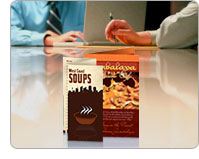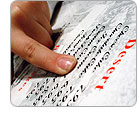- Products
-
Design Templates
- Featured Design Galleries
- More Galleries
- Services & Resources
- Free Sample Kit
- Deals
Good marketing is essential to the success of any restaurant, no matter how great your food is. The large, franchised restaurant chains understand this, but many small, locally owned restaurateurs aren't aware of the best restaurant marketing practices. There are many promotional devices restaurants can use to get patrons in the door, but that's only half the journey on the path to optimized profit margins. Once your diners are seated, your menu is your No. 1 marketing tool to drive your return on investment and overall profits through the roof. Here are five things restaurant marketers forget about restaurant menus, and what you can do to maximize your potential:

If you operate a formal sit-down experience, perhaps the worst thing you can do is include a straight column of prices on your menu. Your customers' dining choices should be predicated on taste and personal preference, not on the price of a meal. Plus, research suggests that when you add prices and dollar signs, customers who otherwise would not consider cost will begin to factor price into their decision-making process. Meals should be compared on substance, not cost. Some restaurants simply omit the dollar sign or place prices at the end of descriptions (versus a straight column), but you're better off excluding prices on your menu altogether. Nobody in a group of diners wants to look cheap by asking how much an entrée will cost them before they order.
Salads, sandwiches, desserts: What sets you apart from the competition and entices your patrons to try any of these things? Normal menu naming conventions simply do not work - they're nothing more than list headers. If you want your menu to sell for you, be unique and creative with your food category names: "Fresh from the Garden" for salads, "Crispy Warm-Ups" for appetizers and "Savory Complements" for side dishes.
While not every item on your menu needs an accompanying picture (your menu would be too convoluted if it did), your featured items should be displayed with prominence. While you're at it, feature only items with the highest profit margins; and include them at the top and bottom of food lists since this is where your customers' eyes will go.
Let's say you're selling cheeseburgers. Compare this: "Grilled ground beef topped with cheese on a bun" to this: "100% Grade A Angus Ground Beef grilled to order and topped with two melted American cheese slices and your choice of fresh red ripe tomatoes, crisp 'n' leafy lettuce, Vidalia onions and our famous red wine sauce." Which one would you order?
 A roughshod menu printed on desktop paper and inserted into a clear folder does not lend the professional look that entices diners to try new things. A professional menu printed full-color on 100-pound gloss text or 50 percent recycled 70-pound matte paper is both attractive and lends credibility to your establishment and your cooks. Remember that your menu is an investment that, when designed correctly, can literally triple your return on investment.
A roughshod menu printed on desktop paper and inserted into a clear folder does not lend the professional look that entices diners to try new things. A professional menu printed full-color on 100-pound gloss text or 50 percent recycled 70-pound matte paper is both attractive and lends credibility to your establishment and your cooks. Remember that your menu is an investment that, when designed correctly, can literally triple your return on investment.